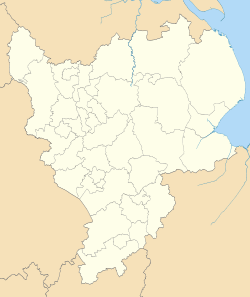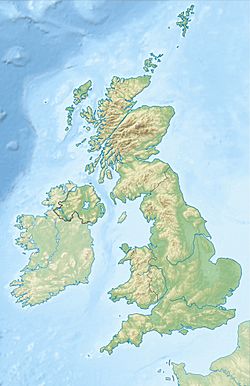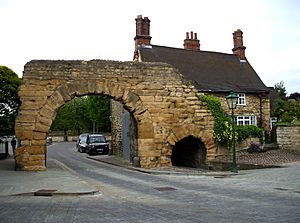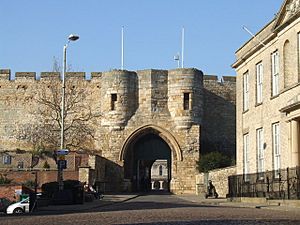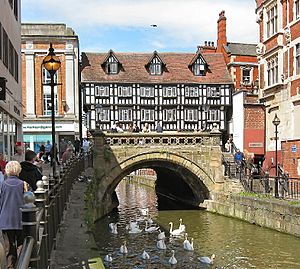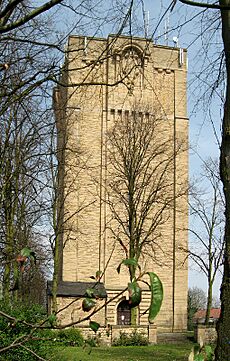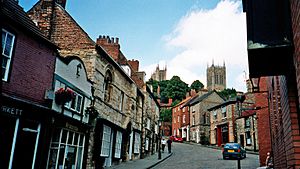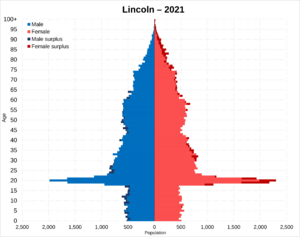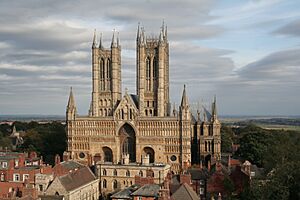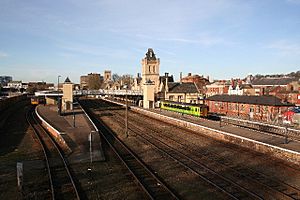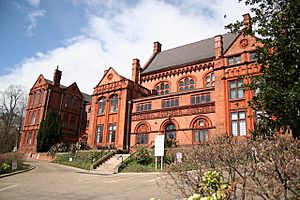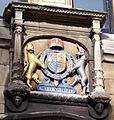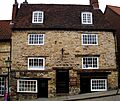Lincoln, England facts for kids
Quick facts for kids
Lincoln
Lindon, Lindum Colonia
|
|||
|---|---|---|---|
|
Cathedral city and non-metropolitan district
|
|||
| Lincoln/City of Lincoln | |||
|
|
|||
|
|||
| Nickname(s):
Tank Town,
|
|||
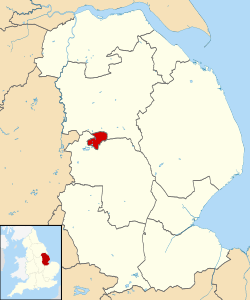
Shown within Lincolnshire
|
|||
| Sovereign state | United Kingdom | ||
| Country | England | ||
| Region | East Midlands | ||
| Ceremonial county | Lincolnshire | ||
| City status | 1072 | ||
| Incorporated | 1 April 1974 | ||
| Administrative centre | Lincoln City Hall | ||
| Wards and suburbs of the city |
List
Abbey (Ward)
Birchwood (Ward) Boultham (Ward) Carholme (Ward) Castle (Ward) Glebe (Ward) Hartsholme (Ward) Minster (Ward) Moorland (Ward) Park (Ward) Witham (Ward) Boultham Moor Bracebridge Bracebridge Heath (Village) Bracebridge Low Fields Burton (Village) Burton Waters Canwick (Village) Canwick Hill Charterholme Cornhill Quarter Ermine Ermine East Ermine West Hykeham Central Hykeham Fosse Monks Road (District) New Boultham Newland (District) Newport (District) North Hykeham (Town) Riseholme (Village) Skellingthorpe (Village) South Hykeham (Village) St Catherine's St Giles Estate Steep Hill Swallowbeck Swanpool Waddington (Village) Waddington Low Fields Washingborough (Village) West End (District) Wigford (District) |
||
| Government | |||
| • Type | Non-metropolitan district | ||
| • Body | City of Lincoln Council | ||
| Area | |||
| • City and District | 13.78 sq mi (35.69 km2) | ||
| Population | |||
| • City and District | 103,813 | ||
| • Rank | 245th (of 326) | ||
| • Density | 1,780/sq mi (687/km2) | ||
| • Urban | 130,200 | ||
| • Metro | 189,000 | ||
| Demonym(s) | Lincolnian, Lincolnite, Lincolner | ||
| Ethnicity (2021) | |||
| • Ethnic groups |
List
|
||
| Religion (2021) | |||
| • Religion |
List
50.7% no religion
45.5% Christianity 2% Islam 0.4% Buddhism 1.4% other |
||
| Time zone | UTC+0 (Greenwich Mean Time) | ||
| • Summer (DST) | UTC+1 (British Summer Time) | ||
| Postcode areas |
LN
|
||
| Dialling codes | 01522 | ||
| ONS code | 32UD (ONS) E07000138 (GSS) |
||
| OS grid reference | SK9771 | ||
| Primary airports | Humberside, East Midlands | ||
| Councillors | 33 | ||
| Member of Parliament | Hamish Falconer (Lab) | ||
Lincoln is a historic cathedral city in Lincolnshire, England. It is the main town of the county. In 2021, the city area had a population of 103,813 people. The larger urban area of Lincoln, which includes nearby towns and villages, had about 127,540 people.
The city started as an Iron Age settlement by Celtic Britons near the River Witham. Later, the Romans built a city called Lindum Colonia there. Over time, its name became Lincoln. Important landmarks include Lincoln Cathedral, which was once the world's tallest building, and the 11th-century Norman Lincoln Castle. Lincoln is also home to the University of Lincoln and Bishop Grosseteste University. It is the biggest city in Lincolnshire.
Contents
- What's in a Name? The Story of Lincoln's Name
- A Journey Through Lincoln's Past
- Lincoln's Economy: How the City Works
- Who Lives in Lincoln? Demographics
- Places of Worship in Lincoln
- Lincoln's Location and Environment
- Getting Around: Transport in Lincoln
- Learning in Lincoln: Education
- News and Entertainment: Media in Lincoln
- Sports in Lincoln: Get Active!
- Famous People from Lincoln
- Global Connections: Twin Towns
- Freedom of the City
- City Symbols: Lincoln's Coat of Arms
- Images for kids
- See also
What's in a Name? The Story of Lincoln's Name
The name Lincoln likely comes from an old Brythonic word, lindon, meaning "The Pool." This probably referred to the Brayford Pool. The Romans later called it Lindum Colōnia. The "coln" part of Lincoln comes from "colonia," meaning "outpost." This shows how the name changed over time.
A Journey Through Lincoln's Past
Lincoln has a very long and interesting history.
Early Beginnings: Iron Age Settlement
Archaeologists found signs of an Iron Age settlement from the 1st century BCE. People lived in round wooden houses near the Brayford Pool and the River Witham. This was at the bottom of a big hill. Later, the Normans built Lincoln Cathedral and Lincoln Castle on top of this same hill.
Roman Lincoln: Lindum Colonia
The Romans took control of this part of Britain in 48 CE. They built a strong fort high on the hill. This fort overlooked the Brayford Pool and the Fosse Way Roman road. The Celtic name Lindon became Lindum in Latin. It was called a Colonia when Roman army veterans settled there.
The fort became a colonia in 71 CE when the Roman army moved to York. Lindum colonia grew to include the hillside down to the water. It became a busy place for trade, connected to the sea by the River Trent and River Witham. By the end of the 5th century, most people had left the city.
Viking and Norman Times: Lincylene
Germanic tribes settled in Lincolnshire in the 5th and 6th centuries. The Latin name Lindum Colonia changed to Lindocolina, then to Lincylene in Old English.
After Viking raids, Lincoln became important again for trade. It even had its own mint for making coins. By the late 10th century, it was as important as York for coin production. After the Danelaw was set up in 886, Lincoln became one of the Five East Midland Boroughs. The Danes helped Lincoln's economy grow a lot.
In 1068, two years after the Norman conquest of England, William the Conqueror ordered Lincoln Castle to be built. He chose the same spot as the old Roman settlement for its good location.
Medieval Wealth: Lincoln's Cloth Trade
By 1150, Lincoln was one of England's richest towns. This was thanks to its cloth and wool trade with Flanders. Lincoln weavers formed a guild in 1130. They made famous "scarlet" and "green" cloth. The legendary Robin Hood was said to wear woollens of Lincoln green.
The old part of the city is still around the Bailgate and down Steep Hill to the High Street. You can see old churches like St Mary le Wigford and St Peter at Gowts from the 11th century.
Lincoln was home to one of England's main Jewish communities. The Jew's House and the Norman House show where Jewish people lived. In 1255, some Lincoln Jews were wrongly accused in an event called "The Libel of Lincoln." They were sent to the Tower of London, and 18 were executed. All Jews were expelled from England in 1290.
In the 13th century, Lincoln was England's third-largest city. It was a favorite place for kings. During the First Barons' War, the city was involved in fighting between the king and rebel barons. In 1217, the French and Rebel army was defeated here.
Decline and Damage: A City's Challenges
Some historians say Lincoln's wealth started to decline in the 14th century. However, others believe it stayed strong in trade into the 15th century. In 1409, Lincoln became a "county corporate," giving it more rights.
The dissolution of the monasteries hurt Lincoln's economy. Many monasteries closed, reducing the region's power. A sign of Lincoln's decline was when the cathedral's great spire fell in 1549 and was not rebuilt. However, this meant that older buildings were preserved instead of being replaced.
During the English Civil War (1642-1651), Lincoln was a battleground. It changed hands many times, and many buildings were damaged. Lincoln had no major industries and no easy way to reach the sea. It struggled while other parts of the country grew.
New Beginnings: Revolutions and Growth
By the Georgian era, Lincoln began to recover. The British Agricultural Revolution helped. Reopening the Foss Dyke canal made it easier to bring in coal and other materials for industry. The city's boundaries also expanded.
Lincoln grew rapidly during the Industrial Revolution. Companies like Ruston's and William Foster's became famous. Lincoln became known for heavy engineering, building locomotives and machinery.
Around this time, the name "Lincoln" also became famous because of U.S. President Abraham Lincoln. His family's name came from the English town of Lincoln. Many places in the U.S. are now named after him.
Modern Lincoln: 20th and 21st Centuries
In 1904-1905, Lincoln had a typhoid outbreak from polluted water. Over 1,000 people got sick, and 113 died. Chlorine was used to disinfect the water, which was an early use of this method. The Westgate Water Tower was built to provide new water supplies.
During the two world wars, Lincoln made war supplies. The first ever tanks were invented and built in Lincoln during the First World War. The city's population grew as more workers were needed. In the Second World War, Lincoln produced tanks, aircraft, and military vehicles.
After 1945, new suburbs appeared. However, heavy industry declined in the late 20th century. The University of Lincoln opened in 1996, leading to much development around the Brayford area. In 2012, Bishop Grosseteste teaching college also became a university.
Lincoln's Economy: How the City Works
About 34% of Lincoln's workers are in public services, education, and health. Another 25% work in shops, restaurants, and hotels.
Old industrial buildings, like those of Ruston (now Siemens), have been turned into new spaces. The University of Lincoln, local radio stations, and gyms now use these buildings. The old Corn Exchange is now a shopping area.
Lincoln also has a growing IT economy. Many online shopping companies are based here. Bifrangi, an Italian company that makes crankshafts for off-road vehicles, is also in Lincoln.
Lincoln is a central point for nearby towns and villages. People from places like Welton and Saxilby come to Lincoln for jobs and services. The University of Lincoln helps the city grow by supporting small businesses, restaurants, and entertainment places.
Tourism: Exploring Lincoln's Attractions

Lincoln is a popular place for tourists. Visitors come to see its historic buildings, including the cathedral, the castle, and the medieval Bishop's Palace.
The Collection museum is a major attraction. It has over 2 million objects and was a finalist for a big prize in 2006. Other places to visit include the Museum of Lincolnshire Life and the International Bomber Command Centre.
You can also find peaceful places like Whisby Nature Reserve and Hartsholme Country Park. For more action, there's Scampton airfield (home of the RAF's Red Arrows jet team) and the Cadwell Park motor racing circuit.
Every December, the Bailgate area hosts a Christmas Market. It's like traditional German Christmas markets.
Who Lives in Lincoln? Demographics
Ethnicity
In the 2021 census, Lincoln's population was 103,813. Most people (82.7%) were White British. Other white groups made up 9.5%. South Asian people were 3.2%, Mixed race people were 2%, and Black people were 1.4%. Other ethnic minorities made up 0.9%.
About 15.1% of people in Lincoln were born outside the UK. The most common countries of birth, besides the UK, were Poland (2.6%), Romania (1.4%), and Lithuania (1.1%).
| Lincoln: Ethnicity: 2021 Census | |||||||||||||
| Ethnic group | Population | % | |||||||||||
|---|---|---|---|---|---|---|---|---|---|---|---|---|---|
| White | 95,665 | 92.2% | |||||||||||
| Asian or Asian British | 3,347 | 3.2% | |||||||||||
| Mixed | 2,068 | 2% | |||||||||||
| Black or Black British | 1,466 | 1.4% | |||||||||||
| Arab | 320 | 0.3% | |||||||||||
| Other Ethnic Group | 948 | 0.9% | |||||||||||
| Total | 103,813 | 100% | |||||||||||
Places of Worship in Lincoln

Lincoln has many churches, both old and new. The Lincoln Central Mosque and Cultural Centre is on Dixon Street. The city does not have Sikh or Hindu temples. The Jewish Lincoln Synagogue is in the ancient building, Jews' Court, on Steep Hill.
Lincoln Cathedral: A Towering History
Building the first Lincoln Cathedral began in 1092. It was rebuilt after a fire and then after an earthquake in 1185. The new cathedral was huge. Its central spire was said to be the tallest in Europe, reaching about 525 feet. When it was finished, it was believed to be the tallest man-made structure in the world.
The bishops of Lincoln were very powerful in medieval England. The Diocese of Lincoln was the largest in England. In 1215, Hugh of Wells, the Bishop of Lincoln, was one of the witnesses when Magna Carta was created. One of the four original copies of this important document is kept in Lincoln Castle.
Famous bishops of Lincoln include St Hugh of Lincoln, who helped build the cathedral, and Robert Grosseteste, a smart thinker from the 13th century. The Lincoln Medieval Bishop's Palace was the administrative center. It was one of England's most important buildings when built in the late 12th century.
Lincoln's Location and Environment
Lincoln is about 67 feet above sea level by the River Witham. It rises to about 246 feet on Castle Hill. The city sits in a gap in the Lincoln Cliff, a ridge that runs north and south. Lincoln is about 55 miles southwest of Hull and 32 miles northeast of Nottingham.
Uphill and Downhill: Two Sides of Lincoln
Because of the hills, Lincoln is often split into two areas: "uphill" and "downhill."
The uphill area is the northern part of the city, on top of the Lincoln Cliff. This includes the historic area with Lincoln Cathedral, Lincoln Castle, and the Medieval Bishop's Palace. This area is known as The Bail. The downhill area includes the city center and southern suburbs. Steep Hill is a narrow, walking-only street that connects the two areas.
This division used to be a class difference, with uphill being richer. This started after the Norman Conquest, when the religious and military leaders lived on the hilltop. Today, new suburbs have made this difference less noticeable.
Nature in Lincoln: Plants and Animals
The mute swan is a special bird for Lincoln. Many pairs nest by the Brayford Pool, and the university uses it in its symbol. Other birds in the city include peregrine falcons and common kingfishers.
Mammals like red foxes and roe deer can be seen on the city edges. Fish like European perch and northern pike live in the Witham and Brayford. Nature reserves around the city include Whisby Nature Park and Hartsholme Country Park.
Since 2016, little egrets have nested in the Birchwood area. Otters have also appeared in the River Witham. Both are native to Britain and are returning to the area.
Some non-native plants and animals have also arrived in Lincoln. Japanese knotweed and Himalayan balsam are Asian plants found near the River Witham. American mink are sometimes seen on the Witham.
Lincoln's Districts and Suburbs
Lincoln has many old suburbs that date back to Roman times. Some notable historic areas include:
- Monks Road - This area is known as the "East End." It has old and new buildings, including All Saints' Church and Lincoln College. It is the most culturally diverse part of the city.
- Newland - This is one of the oldest areas, dating back to 1100. It was once home to Lincoln's port. Today, it has the Brayford Pool and Lincoln University.
- Newport - This area was part of the Roman city of Lindum Colonia. It is famous for landmarks like the Newport Arch and Bishop Grosseteste University.
- West End - This is mostly a residential area. It includes the West Common and the Foss Dyke.
- Wigford - Once separate, this is now the main High Street. It has many landmarks like St Mary le Wigford Church and the Cornhill Quarter.
Other areas include old villages like Boultham Moor and Bracebridge. Lincoln is also growing with a new Western Growth Corridor being built.
Lincoln's Weather: Climate Overview
Lincoln has a typical East Midland maritime climate. This means it has cool summers and mild winters. The nearest weather station is at RAF Waddington, about 4 miles south. Temperatures have ranged from 40.3°C (104.5°F) in July 2022 to -15.6°C (3.9°F) in February 1956.
| Climate data for Waddington, elevation: 68 m (223 ft), 1991–2020 normals, extremes 1948–present | |||||||||||||
|---|---|---|---|---|---|---|---|---|---|---|---|---|---|
| Month | Jan | Feb | Mar | Apr | May | Jun | Jul | Aug | Sep | Oct | Nov | Dec | Year |
| Record high °C (°F) | 14.2 (57.6) |
17.4 (63.3) |
22.4 (72.3) |
27.0 (80.6) |
27.8 (82.0) |
32.6 (90.7) |
40.3 (104.5) |
34.8 (94.6) |
30.0 (86.0) |
29.2 (84.6) |
17.8 (64.0) |
15.5 (59.9) |
40.3 (104.5) |
| Mean daily maximum °C (°F) | 7.0 (44.6) |
7.7 (45.9) |
10.2 (50.4) |
13.1 (55.6) |
16.3 (61.3) |
19.1 (66.4) |
21.6 (70.9) |
21.4 (70.5) |
18.3 (64.9) |
14.1 (57.4) |
9.9 (49.8) |
7.2 (45.0) |
13.9 (57.0) |
| Daily mean °C (°F) | 4.3 (39.7) |
4.7 (40.5) |
6.6 (43.9) |
9.0 (48.2) |
12.0 (53.6) |
14.8 (58.6) |
17.1 (62.8) |
17.0 (62.6) |
14.4 (57.9) |
10.9 (51.6) |
7.1 (44.8) |
4.6 (40.3) |
10.2 (50.4) |
| Mean daily minimum °C (°F) | 1.6 (34.9) |
1.7 (35.1) |
3.0 (37.4) |
4.9 (40.8) |
7.6 (45.7) |
10.5 (50.9) |
12.7 (54.9) |
12.6 (54.7) |
10.5 (50.9) |
7.6 (45.7) |
4.3 (39.7) |
2.0 (35.6) |
6.6 (43.9) |
| Record low °C (°F) | −13.8 (7.2) |
−15.6 (3.9) |
−11.1 (12.0) |
−4.7 (23.5) |
−2.0 (28.4) |
0.0 (32.0) |
3.3 (37.9) |
3.9 (39.0) |
0.0 (32.0) |
−3.2 (26.2) |
−6.7 (19.9) |
−14.0 (6.8) |
−15.6 (3.9) |
| Average precipitation mm (inches) | 47.6 (1.87) |
38.4 (1.51) |
36.4 (1.43) |
44.3 (1.74) |
47.0 (1.85) |
60.3 (2.37) |
60.3 (2.37) |
58.3 (2.30) |
52.0 (2.05) |
61.4 (2.42) |
56.9 (2.24) |
51.9 (2.04) |
614.8 (24.20) |
| Average precipitation days (≥ 1.0 mm) | 10.6 | 9.0 | 8.6 | 8.9 | 8.9 | 9.3 | 9.2 | 9.3 | 8.7 | 10.7 | 11.6 | 10.7 | 115.5 |
| Average relative humidity (%) | 86 | 84 | 80 | 79 | 77 | 77 | 77 | 79 | 80 | 84 | 85 | 87 | 81 |
| Mean monthly sunshine hours | 62.2 | 86.0 | 125.6 | 168.2 | 211.6 | 190.8 | 206.3 | 192.0 | 146.7 | 109.3 | 71.3 | 61.3 | 1,631.2 |
| Source 1: Met Office NOAA (Relative humidity 1961–1990) | |||||||||||||
| Source 2: KNMI | |||||||||||||
| Climate data for Scampton, elevation: 57 m (187 ft), 1991–2020 normals | |||||||||||||
|---|---|---|---|---|---|---|---|---|---|---|---|---|---|
| Month | Jan | Feb | Mar | Apr | May | Jun | Jul | Aug | Sep | Oct | Nov | Dec | Year |
| Mean daily maximum °C (°F) | 6.9 (44.4) |
7.7 (45.9) |
10.2 (50.4) |
13.2 (55.8) |
16.2 (61.2) |
19.1 (66.4) |
21.6 (70.9) |
21.4 (70.5) |
18.4 (65.1) |
14.1 (57.4) |
9.8 (49.6) |
7.0 (44.6) |
13.8 (56.8) |
| Daily mean °C (°F) | 4.0 (39.2) |
3.9 (39.0) |
6.3 (43.3) |
8.7 (47.7) |
11.6 (52.9) |
14.5 (58.1) |
16.8 (62.2) |
16.7 (62.1) |
14.1 (57.4) |
10.6 (51.1) |
6.6 (43.9) |
4.1 (39.4) |
9.9 (49.8) |
| Mean daily minimum °C (°F) | 1.1 (34.0) |
1.0 (33.8) |
2.3 (36.1) |
4.1 (39.4) |
7.0 (44.6) |
10.0 (50.0) |
12.1 (53.8) |
12.0 (53.6) |
9.8 (49.6) |
7.0 (44.6) |
3.6 (38.5) |
1.1 (34.0) |
5.9 (42.6) |
| Average precipitation mm (inches) | 48.9 (1.93) |
38.6 (1.52) |
35.9 (1.41) |
44.5 (1.75) |
45.8 (1.80) |
65.0 (2.56) |
58.8 (2.31) |
57.4 (2.26) |
53.0 (2.09) |
58.2 (2.29) |
59.9 (2.36) |
53.5 (2.11) |
619.4 (24.39) |
| Average precipitation days (≥ 1.0 mm) | 10.6 | 9.5 | 8.8 | 9.0 | 8.9 | 9.6 | 9.6 | 9.4 | 9.4 | 10.4 | 11.9 | 11.0 | 118.1 |
| Source: Met Office | |||||||||||||
Getting Around: Transport in Lincoln
Train Travel: Lincoln's Railway Connections
Lincoln railway station connects to four railway lines. You can take direct trains to London King's Cross, Leicester, Nottingham, and other cities. Hykeham railway station serves the southwestern suburbs.
Roads: Driving in and Around Lincoln
Major roads like the A57, A46, A15, and A158 pass through Lincoln. To help with traffic, bypasses have been built. The A46 bypass opened in 1985. The A15 Eastern bypass was finished in December 2020. A southern bypass, the North Hykeham relief road, is planned to start construction in 2025. This will complete a full ring road around the city.
Airports: Flying from Lincoln
East Midlands Airport, about 43 miles from Lincoln, is the main international airport. It mostly handles flights within Europe. Humberside Airport, 29 miles north, has fewer flights, mainly to larger hub airports.
Learning in Lincoln: Education
Universities: Higher Education Opportunities
Lincoln has two universities. Bishop Grosseteste University started in 1862 as a teacher training college. It became a university in 2012. Its graduation ceremonies are held in Lincoln Cathedral.
The larger University of Lincoln opened its campus by Brayford Pool in 1996. It absorbed other colleges and changed its name in 2002. In the 2021–2022 school year, over 18,705 students studied at universities in Lincoln.
Colleges: Further Education
Lincoln College is Lincolnshire's largest education institution. It has 18,500 students. Access Creative is a special college for music, media, and games design.
Schools: Primary and Secondary Education
Lincoln's school system is different from most of Lincolnshire. The county mostly uses grammar schools, but Lincoln does not.
Several schools in Lincoln are part of The Priory Federation of Academies. These include The Priory Academy LSST and The Priory Witham Academy. These schools have been rebuilt with significant investment.
Lincoln also has four special-needs schools for different age groups.
News and Entertainment: Media in Lincoln
The local newspaper is the Lincolnshire Echo, started in 1894. Local radio stations include BBC Radio Lincolnshire and Greatest Hits Radio Lincolnshire. Lincoln City Radio is a community station for listeners over 50. The Lincolnite, an online publication, stopped trading in August 2024.
The Linc is a student publication for the University of Lincoln. Local TV news comes from BBC Yorkshire and Lincolnshire and ITV Yorkshire.
Sports in Lincoln: Get Active!
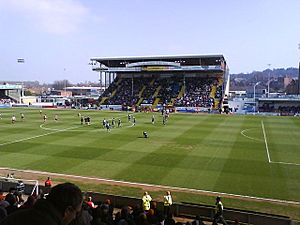
Lincoln's professional football team is Lincoln City FC, also known as "The Imps." They play at the Sincil Bank stadium. In 2002, fans helped save the club from bankruptcy. Lincoln City was the first club to be relegated from the English Football League in 1986–87. They returned to the league and stayed until 2010–11.
Graham Taylor, who later managed the England national football team, started his managing career at Lincoln City from 1972 to 1977. The club won promotion in 1976. Lincoln City reached the FA Cup quarter-finals in 2017. They won Football League Two in 2018–2019 and the EFL Trophy in 2018.
Lincoln is also home to other football teams like Lincoln United FC. The city hosts the Lincoln Grand Prix, a cycle race that includes the challenging Michaelgate hill. Lincoln also has American football and roller derby teams. The Lincoln Lions rugby union team has been playing since 1902.
Famous People from Lincoln
Many notable people have connections to Lincoln:
- George Boole (1815–1864), a mathematician who created Boolean logic, was born in Lincoln.
- William Byrd (c. 1539–1623), a famous composer and organist, worked at Lincoln Cathedral.
- John Hurt (1940–2017), a well-known actor, attended Lincoln School.
- Neville Marriner (1924–2016), a violinist and conductor, was born and educated in Lincoln.
- Paul Palmer (born 1974), a swimmer, won an Olympic silver medal in 1996.
- William Tritton (1875–1946), helped develop the military vehicle, the tank.
Global Connections: Twin Towns
Lincoln is twinned with several cities around the world:
- Neustadt an der Weinstraße, Germany (since 1969)
- Port Lincoln, Australia (since 1991)
- Radomsko, Poland (since 2007)
- Tangshan, China (since 1988)
- Nanchang, China (since 2014)
Freedom of the City
The "Freedom of the City" is a special honor given to individuals or military units.
Individuals
- Edward Fiennes-Clinton, 18th Earl of Lincoln: 1989
- Lord Cormack: 18 March 2022.
Military Units
- RAF Waddington: 25 April 1959.
- RAF Scampton: 14 May 1993.
- 2nd Battalion The Royal Anglian Regiment: 1997.
- The Grenadier Guards: 8 May 2008.
City Symbols: Lincoln's Coat of Arms
|
Lincoln's coat of arms is believed to be from the 14th century. It shows a red cross on a silver background with a gold fleur-de-lis. The cross comes from the Diocese, and the fleur-de-lis represents the cathedral's dedication to the Virgin Mary. The motto is CIVITAS LINCOLNIA, which means "City of Lincoln."
Images for kids
-
St Swithin's Church, in the city centre
-
Sincil Bank, home of Lincoln City F.C.
-
Waterside Empowerment 2002 sculpture
See also
 In Spanish: Lincoln (Reino Unido) para niños
In Spanish: Lincoln (Reino Unido) para niños










